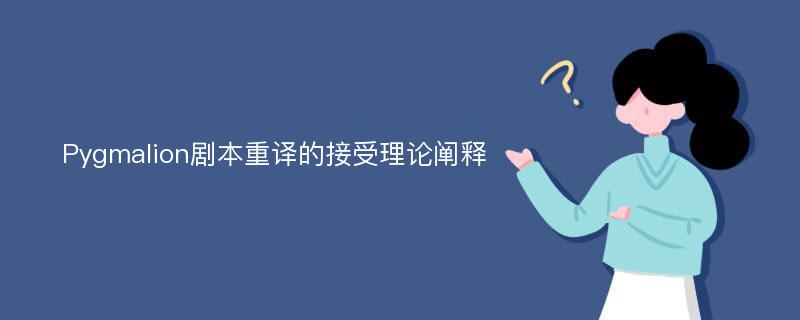
论文摘要
在文学作品的翻译中,重译现象十分普遍。同一个文本,不同译者往往有不同译本,即使同一译者,也会有不同译本。我国传统翻译理论在对译文评价标准的探讨中注重原文、译文的对比,追求译文与原文之间的对等,希望能译出特定文学文本的理想定本或标准译本。同时,这种以作者为中心或者以文本为中心的研究方法也很少涉及译者的能动作用。接受理论的出现,标志着文学批评理论由重作者、重作品向重文本—读者关系的转变。本文理论观点主要引用康士坦茨学派的两位主要代表人物汉斯·罗伯特·姚斯和沃尔夫冈·伊瑟尔以及两位前人伽达默尔和英伽登的学术思想。具体说来,本文主要运用姚斯的“期待视野”以及伊瑟尔的“未定性”等接受理论观点,通过对萧伯纳的戏剧Pygmalion的三个中文译本(林语堂1929年译本;杨宪益1982和1987年译本)进行比较分析,在着重探讨、分析原文和译文以及三个译本差异的基础上,从译者角度,探讨了翻译过程中译者的接受和阐释活动,译者与其他创造和接受主体的关系等问题,从而尝试阐发重译现象存在的理论根据及重译的必然性。根据接受理论观点,文学文本是在读者阅读过程中才现实地转化为文学作品的,文本的潜在意义是由读者的参与才得以实现的。在翻译过程中,不同的译者,在各自前理解或先在的知识结构的指导下,会对同一原作做出不同的阐释。同时,每位译者都竭力实现原作者,译者和读者三者之间的视野融合。然而,由于种种因素的限制,在实际的翻译过程中,三个主体间的视野不能完全融合,因此,重译现象必然发生。此外,文学作品包含确定性和未定性两部分。一方面,确定性指导读者的阅读和阐释,另一方面,未定性又引导读者在阅读过程中发挥创造性。因此,每一位译者,在主体性的指导下,对原文中的空白或未定性会做出不同的具体化。于是,对于同一原作,就会出现不同的阐释。和其它文学作品一样,以演出为目的的戏剧剧本也由确定性和未定性两部分构成。为了实现原剧本,导演和/或演员,目标读者和观众以及译者之间的视野融合,译者需要找出原作中的确定性部分,并尽力使之在译文中得到相似的表达。同时,对于原作中未定性部分,需要译者运用想象力、创造性和技巧等等,简言之,即译者的主体性去探查,使之具体化。对于可能会阻碍实时观众反应的未确定的地方,译者在译文中或删除或填充,尽力使目的语观众能得到与原作对于原语观众相似的反应。因此,剧本的重译现象同样不可避免。总之,本文在运用接受理论对重译现象进行理论探讨和对Pygmalion译本比较分析的基础上得出结论:重译现象不仅可以用接受理论来阐释,而且重译现象必然发生,通过重译活动可以提高翻译质量。不过,任何一个译本,哪怕是重译本都还有改进的余地,换句话说,没有一个译本可以称为最后的定本。
论文目录
AcknowledgementsAbstract摘要Chapter One Introduction1.1 Research Questions1.2 Research Methodology1.3 Significance of the Research1.4 Layout of the ThesisChapter Two Literature Review2.1 Retranslation-related Studies in China2.1.1 Necessity and Significance of Literary Retranslation2.1.2 Qualifications or Requirements for Retranslation2.1.3 Explorations for Theoretical Explanations of Retranslation2.2 Pygmalion's Retranslation-related Studies in China2.3 Reception Theory-related Studies of Literary Translation in China2.3.1 Explorations for the Nature of Translation from the Reception Theory Perspective2.3.2 Emphasis on the Translator's Subjective Role in the Translation Process as a Receptor2.3.3 Emphasis on the Target Readers' Referential Role and Their Responses2.3.4 Application of Some Key Terms and Ideas of Reception Theory in the Explanation of the Translation PracticeChapter Three Characteristics of the Drama Translation3.1 The Definition of the Drama3.2 The Features of the Drama Text3.3 The Specifics of the Performance-oriented Drama TranslationChapter Four Reception Theory and Its Interpretation of the Retranslation of Pygmalion4.1 Reception Theory and Its Main Viewpoints4.1.1 Two Major Precursors4.1.2 Two Major Representatives and Their Academic Views4.1.2.1 Hans Robert Jauss and His "Horizon of Expectations"4.1.2.2 Wolfgang Iser and His "Indeterminacy"4.2 Theoretical Interpretation of the Retranslation of Pygmalion4.2.1 The Translator's Dual Role and Subjectivity in the Translating Process4.2.1.1 Translator's Reception4.2.1.2 Translator's Subjectivity4.2.2 Fusion of Horizons of Three Translating Entities4.2.2.1 Original Author's Horizons of Expectations4.2.2.2 Translator's Horizons of Expectations4.2.2.3 Reader's Aesthetic Expectations4.2.2.4 Impossibility of Achieving Perfect Fusion of Horizons4.3 SummaryChapter Five ConclusionBibliographyAppendix
相关论文文献
标签:文学翻译论文; 戏剧翻译论文; 重译论文; 接受理论论文; 期待视野论文; 未定性论文;

